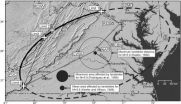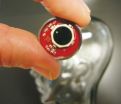(Press-News.org) No matter what climate you live in, you're more likely to die of heart-related issues in the winter, according to research presented at the American Heart Association's Scientific Sessions 2012.
"This was surprising because climate was thought to be the primary determinant of seasonal variation in death rates," said Bryan Schwartz, M.D., lead author of the study.
Researchers at Good Samaritan Hospital in Los Angeles analyzed 2005-08 death certificate data from seven U.S. locations with different climates: Los Angeles County, Calif.; Texas; Arizona; Georgia; Washington; Pennsylvania and Massachusetts.
In all areas, total and "circulatory" deaths rose an average 26 percent to 36 percent from the summer low to the winter peak over four years. Circulatory deaths include fatal heart attack, heart failure, cardiovascular disease and stroke.
Seasonal patterns of total and cardiac deaths were very similar in the seven different climate patterns. Death rates at all sites clustered closely together and no one site was statistically different from any other site.
Researchers didn't design the analysis to determine specific causes that might drive heart-related deaths up in winter. Schwartz hypothesized that colder weather might increase vessel constriction and raise blood pressure.
"In addition, people generally don't live as healthy in winter as they do in summer," said Schwartz, now a cardiology fellow at the University of New Mexico in Albuquerque. "They don't eat as well and don't exercise as much."
However, "people should be extra aware that maintaining healthy behaviors is important in winter," he said.
Schwartz and Robert Kloner, M.D., Ph.D., senior author of the study, used statistical techniques to account for the normal year-to-year temperature differences over the four years. Then, they averaged the resulting four-year data into U-shaped curves for each site and compared them. The graphs showed significant similarities.
###
Funding and disclosure information is on the abstract.
For more information about cold weather and cardiovascular disease, visit heart.org/coldweather.
Follow news from AHA Scientific Sessions 2012 via Twitter: @HeartNews.
Statements and conclusions of study authors that are presented at American Heart Association scientific meetings are solely those of the study authors and do not necessarily reflect association policy or position. The association makes no representation or warranty as to their accuracy or reliability. The association receives funding primarily from individuals; foundations and corporations (including pharmaceutical, device manufacturers and other companies) also make donations and fund specific association programs and events. The association has strict policies to prevent these relationships from influencing the science content. Revenues from pharmaceutical and device corporations are available at www.heart.org/corporatefunding.
Note: Actual presentation is 11 a.m. PT Wednesday, Nov. 7, 2012 in Room 502a.
All downloadable video/audio interviews, B-roll, animation and images related to this news release are on the right column of the release link at http://newsroom.heart.org/pr/aha/_prv-heart-related-deaths-increase-239568.aspx.
Video clips with researchers/authors of studies will be added to the release links after embargo.
General B-roll and Photos
Heart-related deaths increase in winter regardless of climate
Abstract: 11723
2012-11-06
ELSE PRESS RELEASES FROM THIS DATE:
Drug trio improved effectiveness of cancer treatment, protected heart
2012-11-06
Combining cancer medication with a drug for erectile dysfunction and one for heart transplants helped kill cancer cells and protected the heart from damage, in a study presented at the American Heart Association's Scientific Sessions 2012.
For decades, doxorubicin has been a powerful anti-cancer treatment for various human cancers, including breast, ovarian, colon and prostate. But its use has been limited due to harmful, possibly irreversible effects on the heart.
In this study, using cell and animal models, researchers found that sildenafil alone or in combination with ...
2011 Virginia quake triggered landslides at extraordinary distances
2012-11-06
The 2011 Mineral, Virginia M-5.8 earthquake was felt over an extraordinarily large area. A new study details landslides triggered by the earthquake at distances four times greater and over an area 20 times larger than previously documented for M-5.8 earthquakes worldwide.
The study, to be published in the December issue of the Bulletin of the Seismological Society of America (BSSA), describes physical confirmation of previous observations that ground shaking from earthquakes in the eastern U.S. travels farther than in the western U.S, a plate-boundary region.
U.S. ...
Surprising findings from NHLBI Exome Sequencing Project reported
2012-11-06
A multi-institutional team of researchers has sequenced the DNA of 6,700 exomes, the portion of the genome that contains protein-coding genes, as part of the National Heart, Lung and Blood Institute (NHLBI)-funded Exome Sequencing Project, one of the largest medical sequencing studies ever undertaken.
Scientists participating in the project initially expected that individual rare variants would have a greater effect on over 80 heart, lung and blood related traits and diseases of high public health significance, said Suzanne M. Leal, Ph.D., professor and director, Center ...
New study finds that 75 percent of patients taking popular blood-thinners are getting wrong dose
2012-11-06
SALT LAKE CITY – Cardiology researchers at the Intermountain Medical Center Heart Institute have found that approximately 75 percent of patients taking two common blood-thinning drugs may be receiving the wrong dosage levels, according to a new study.
This could put them at risk for serious problems like uncontrolled bleeding or developing blood clots.
Millions of Americans with coronary artery disease take one of the two drugs — clopidogrel (Plavix) and prasugrel (Effient) — to prevent harmful blood clots that can cause a stroke or heart attack. Current guidelines ...
Researchers discover immune pathway
2012-11-06
Researchers from Aarhus University, Denmark, have now discovered an important mechanism behind one of our most fundamental lines of immune function. The discovery has been published in the esteemed scientific journal, The Journal of Immunology, where it has been highlighted as a top story.
In collaboration with colleagues from USA and Turkey, they have discovered exactly which enzymes collaborate in the first line of the immune defence. Thus, they answer a central question about the so-called complement system, which has been a focal point of the scientific field for the ...
Clever cockatoo with skilled craftmanship
2012-11-06
VIDEO:
Figaro, a Goffin's Cockatoo, makes and uses a tool.
Click here for more information.
Goffin's cockatoos are a highly playful and curious Indonesian cockatoo species. Therefore, cognitive biologists are now using them as a model species to investigate intelligent behaviour in birds. Together with researchers from the University of Oxford, Alice Auersperg and Birgit Szabo from the Department of Cognitive Biology at the University of Vienna have made a sensational discovery: ...
A new computational method for timing the tree of life
2012-11-06
With its deeply embedded roots, sturdy trunk and dense profusion of branches, the Tree of Life is a structure of nearly unfathomable complexity and beauty. While major strides have been made to establish the evolutionary hierarchy encompassing every living species, the project is still in its infancy.
At Arizona State University's Biodesign Institute, Sudhir Kumar has been filling in the Tree of Life by developing sophisticated methods and bioinformatics tools. His latest research, which appeared on the advance online edition of the Proceedings of the National Academy ...
A new development in the relief of spasms related to amyotrophic lateral sclerosis
2012-11-06
Amyotrophic lateral sclerosis (ALS) is a neurodegenerative disease with an occurrence rate in France similar to multiple sclerosis (two to three new cases per year for every 100,000 residents). It has a specific affect on neurons responsible for motor control, in particular motor neurones and central motor neurones. The former, located in the spinal cord, are directly linked to muscles and are used for muscle contraction and stretching. The latter, located in the brain, receive movement orders. As the disease develops, the neurons degenerate and the muscles are no longer ...
Pressure switch inside the head
2012-11-06
To this day it remains a mystery why the cerebral pressure in certain people suddenly increases. The consequences, however, are better understood: The blood circulation is disrupted and after a while parts of the brain may die off, similar to what occurs in a stroke. This is how dementia takes its insidious path. Experts estimate that up to ten percent of all cases of dementia in Europe can be attributed to rising blood pressure in the brain. Still, making the diagnosis is tough. People with a heightened susceptibility to a rise in intracranial pressure must be treated ...
Quality products from rubber residues
2012-11-06
Each year throughout the world, up to 22 million tons of rubber are processed and a large portion of it goes into the production of vehicle tires. Once the products reach the end of their useful life, they typically land in the incinerator. In the best case, the waste rubber is recycled into secondary products. Ground to powder, the rubber residues can be found, for example, in the floor coverings used at sports arenas and playgrounds, and in doormats. But until now, the appropriate techniques for producing high-quality materials from these recyclables did not exist. Researchers ...
LAST 30 PRESS RELEASES:
Making lighter work of calculating fluid and heat flow
Normalizing blood sugar can halve heart attack risk
Lowering blood sugar cuts heart attack risk in people with prediabetes
Study links genetic variants to risk of blinding eye disease in premature infants
Non-opioid ‘pain sponge’ therapy halts cartilage degeneration and relieves chronic pain
AI can pick up cultural values by mimicking how kids learn
China’s ecological redlines offer fast track to 30 x 30 global conservation goal
Invisible indoor threats: emerging household contaminants and their growing risks to human health
Adding antibody treatment to chemo boosts outcomes for children with rare cancer
Germline pathogenic variants among women without a history of breast cancer
Tanning beds triple melanoma risk, potentially causing broad DNA damage
Unique bond identified as key to viral infection speed
Indoor tanning makes youthful skin much older on a genetic level
Mouse model sheds new light on the causes and potential solutions to human GI problems linked to muscular dystrophy
The Journal of Nuclear Medicine ahead-of-print tip sheet: December 12, 2025
Smarter tools for peering into the microscopic world
Applications open for funding to conduct research in the Kinsey Institute archives
Global measure underestimates the severity of food insecurity
Child survivors of critical illness are missing out on timely follow up care
Risk-based vs annual breast cancer screening / the WISDOM randomized clinical trial
University of Toronto launches Electric Vehicle Innovation Ontario to accelerate advanced EV technologies and build Canada’s innovation advantage
Early relapse predicts poor outcomes in aggressive blood cancer
American College of Lifestyle Medicine applauds two CMS models aligned with lifestyle medicine practice and reimbursement
Clinical trial finds cannabis use not a barrier to quitting nicotine vaping
Supplemental nutrition assistance program policies and food insecurity
Switching immune cells to “night mode” could limit damage after a heart attack, study suggests
URI-based Global RIghts Project report spotlights continued troubling trends in worldwide inhumane treatment
Neutrophils are less aggressive at night, explaining why nighttime heart attacks cause less damage than daytime events
Menopausal hormone therapy may not pose breast cancer risk for women with BRCA mutations
Mobile health tool may improve quality of life for adolescent and young adult breast cancer survivors
[Press-News.org] Heart-related deaths increase in winter regardless of climateAbstract: 11723




